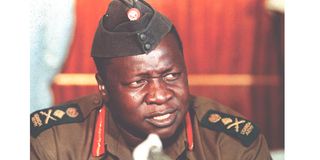Meet the princess who rejected Idi Amin’s sexual advances

Former Ugandan president Idi Amin Dada. Memoir reveals that he ordered the torture of the princess of Toro for rejecting his sexual advances.
What you need to know:
- Princess Elizabeth Bagaya Nyabongo descended from the Toro Kingdom in south-western Uganda.
- She was the eldest daughter of George Omukama Rukidi, the king of Toro; and the niece of Kabaka Mutesa II, the king of Buganda.
- She was made minister as part of a scheme to lure her into a relationship; refusal led to her dismissal, torture and house arrest.
Princess Elizabeth Bagaya Nyabongo descended from the Toro Kingdom in south-western Uganda. She was the eldest daughter of George Omukama Rukidi, the king of Toro; and the niece of Kabaka Mutesa II, the king of Buganda.
As a royal, she enjoyed a privileged education in Uganda and Britain. Attending the affluent Gayaza High School in Buganda and the palatial Sherborne School for Girls in Dorsetshire County, South West of England, where she was the only black student.
She subsequently moved to the prestigious Cambridge University, where she was one of only three African women. She graduated with a law degree in 1962, and was admitted to the English bar in November 1965, becoming the first female barrister in East and Central Africa. Shortly after, she was informed that her father had unexpectedly died.
Her mother, Queen Kezia, requested her to return to Toro and assist her brother, Kaboyo Olimi, with his coronation. Elizabeth's stay in Toro was short. Then Ugandan President Milton Obote abolished the Toro monarchy in September 1967.

The cover of the autobiography of Princess Elizabeth of Toro.
Elizabeth fled Uganda, with her period in exile beginning in London, where, at the invitation of Princess Margaret and Lord Snowdon, she took part in a Commonwealth pageant.
On the runway, she created an exhilaration with her elegant appearance. She was inundated with lucrative modelling offers and began gracing the covers of the world's prominent fashion magazines, including Harper's Bazaar and British and American Vogue.
Former American first lady Jacqueline Kennedy introduced her to then editor-in-chief of American Vogue, Diana Vreeland. Diana invited her for a visit to New York City, where Elizabeth signed a modelling contract with the illustrious Ford Modelling Agency. She went on to appear in Look, Life, and Ebony magazine covers. She also began taking acting lessons, ultimately winning the lead female role in the 1971 film version of Chinua Achebe’s bestselling novel, Things Fall Apart.
By the time Idi Amin seized power in a Coup d’etat on January 25, 1971, Elizabeth was an international superstar, famously known by her stage name, Elizabeth of Toro. Given her tremendous success and popularity in Uganda and abroad, minister of planning and economic development, Apollo Kironde, suggested to Amin that Elizabeth would make an excellent roving ambassador.
Although the two had never met, Amin invited her to return to Uganda and the two came to a profound agreement. On July 21, 1971, Amin formally appointed her as the country’s first roving ambassador.
He knew Elizabeth's eloquence, exposure and acumen would lend respectability to his regime abroad, by disseminating a positive verbal dispatch to the global community. He also knew her smooth persuasive fluency would glitter his image domestically, thus making his military autocracy more palatable to Ugandans.
She began her duties with diligence, encouraging women to embrace modernity. During a speech at a women’s leadership seminar held at Makerere University in early 1972, she urged female participants not to fear negating their femininity, when they accomplished their career goals. She motivated them to seek pride in their womanhood and pursue their dreams, enlightening them that it was admirable for a woman to be educated, ambitious and financially secure.
Amin became intimately interested in her and invited her to join him on a trip to Riyadh, Saudi Arabia. When she repudiated his advances, he demoted her from her position, informing her that he no longer needed a roving ambassador. Chastising her to focus her attention on national issues.
His obsession with Elizabeth emboldened him to instil a surveillance misadventure on her movements. He commanded security personnel to accompany her on each of her trips and report back on her conduct. He also issued warnings to government officials to desist from flirting with her. When Elizabeth took a short leave of absence, Amin ordered security agents to stalk her private movements.
According to Elizabeth's accounts in her autobiography, Elizabeth of Toro: The Odyssey of an African Princess, in a consistent effort to seduce and marry Elizabeth, Amin appointed her the foreign affairs minister on February 19, 1974. She became the first female cabinet minister in Ugandan history, replacing Michael Ondoga, who Amin murdered 24 hours after his dismissal.
His sexual advances having been consistently rejected, Amin maliciously started a vindictive smear campaign against Elizabeth, claiming that on her way back to Uganda from the United Nations General Assembly in New York, she had sex with a Frenchman in a toilet, when on transit in Orly Airport in Paris.
Amin later sent his friend, Roy Innis, an American-born leader of the Congress of Racial Equality (Core), to Elizabeth. Innis tried to dissuade Elizabeth from rejecting Amin's marriage proposal. Appalled, Elizabeth vehemently declined. She was then relieved of her ministerial duties, arrested and tortured at the notorious SRC headquarters in Kampala, and her head shaved using broken glass.
Ugandan authorities were unable to charge her with a crime. They, therefore, placed her under house arrest. She escaped and eventually fled Uganda, crossing the Kenyan border on February 8, 1975. She didn't return to Uganda until 1980, after Amin had been deposed, overthrown and exiled by Tanzania's Bakombozi liberators.
The reviewer is a novelist, Big Brother Africa 2 Kenyan representative and founder of Jeff's Fitness Centre (@jeffbigbrother).





